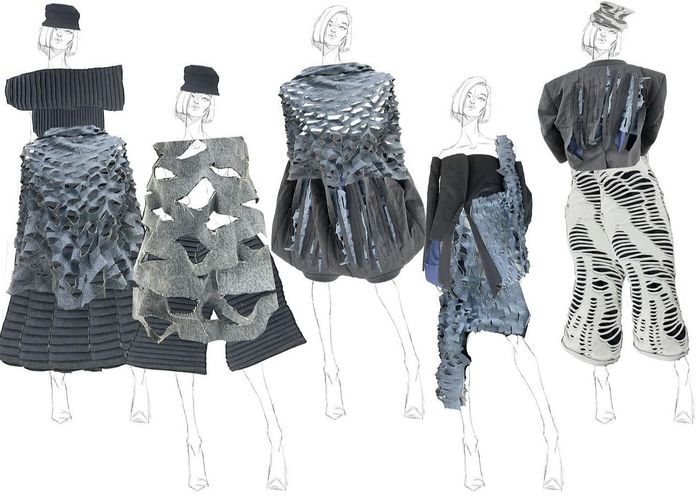Modelling, AI, and the unrealistic body image
Hannah Drayton explores the strengths and limitations of replacing human models with AI

As AI advances, AI models become increasingly prevalent. In 2023, there was even a “meta fashion week” consisting entirely of digital designs on AI models. You can see why AI models would seem attractive to brands –tthey save money on hiring models, hair stylists, make-up artists, and even casting/hiring agents, as well as all of the other costs that go into working with actual people.
Last year, Levi’s announced that they would be partnering with AI studio Lalaland.ai to create AI-generated models in an attempt to increase the diversity of their models and create a more personalised and inclusive experience for customers. On the one hand, giving people a better sense of what clothes will look like on a wider variety of "models" will make it easier for customers to assess how clothes might fit them. This may, in turn, be more sustainable, since there will be less of a need to buy, and then return, multiple sizes and styles if people can better gauge what will fit before they press 'checkout'. An estimated 50% of these returned items go straight to landfill.
“Levi’s is taking jobs away from diverse models while utilising the name of ‘advancement’ to legitimise an exercise in cost-cutting”
But what about Levi’s purported aim of increasing diversity? While their project may allow people to encounter a wider range of images on their website, I struggle to see how hiring fewer diverse models is going to do much to increase diversity in modelling. Levi’s is planning to use AI-generated models alongside actual models, claiming that they aren’t trying to replace human models. In reality, however, it’s likely that, while straight-size models remain employed, the spaces and opportunities for diverse models will shrink as AI’s role in the industry expands. In a climate with a notable shrinking in fashion sizes, with a notable plummet in the number of plus and mid-size models appearing on runways and a returning glorification of skinniness and “cocaine chic”, these performative attempts to increase the diversity of models are helping to ensure the opposite. Levi’s is taking jobs away from diverse models while utilising the name of "advancement" to legitimise an exercise in cost-cutting.
Moreover, what impact might the increasing prevalence of AI-generated models have on body image? It cannot be healthy for the new 'standards' we see to not just be unrealistic, but wholly unreal. Currently, companies are under no legal obligation to disclose which images are AI-generated, so as AI advances and it becomes harder to differentiate between human and non-human models, the unreal beauty standards that AI can fulfil will become more and more normalised. This is not to say that the images of human models provide a realistic body image either, but AI models will be able to set and fulfil an even more extreme standard of ‘perfection’. It has been revealed that extensive exposure to extreme body standards has a detrimental impact on body image and individual psychology, especially for young people. At a time when social media and its images are all-pervasive, is an increased amount of entirely constructed body images being sold as an ‘ideal’, really a good idea?
“At a time when social media and its images are all-pervasive, is an increased amount of entirely constructed body images being sold as an ‘ideal’, really a good idea?”
And what about the rights that models have to images of their bodies? A survey conducted by the nonprofit group Model Alliance found that 18% of responders were asked to have body scans conducted so that 3D models of their faces and bodies could be produced without ever being told what they would be used for. Sarah Ziff, the founder of Model Alliance, also explains that most models surrender legal control to their agencies when they sign an agreement with a brand. Many never see this contract, leading many to worry that their appearances are being used by AI companies without their knowledge. This is especially concerning given the rise of deepfake porn, and even more so given that models in the US (where a lot of modelling takes place) have no union, with minimal protection from exploitation.
It’s also important to note that the real selling power of a model comes from forming a connection with them as a person. Look at the enduring appeal of the 90s Supermodels, revered for their position in the social consciousness as cultural icons that completely transcend individual images. This is why well-known models earn so much more – people will inevitably pay more attention (and thus more money) to a brand that can count Bella Hadid as a wearer of its designs. Is there not an extent to which models are intentionally positioned as something we are supposed to aspire towards? We are sold the idea that this person is conventionally attractive and smiling and therefore their life is amazing and if you just buy this shirt they’re wearing you will look just like them and therefore your life will become better. This is the mentality that spurs on beauty standards and horrifying body image expectations and is undercut by the same mentality (conventionally attractive = good person) that creates “pretty privilege”, and is where the appeal of the model comes from.
Increased amounts of AI modelling will not remove the pressure to look like the images in adverts, and will in all likelihood create much more harmful body standards. By taking away the actual human element, they are unlikely to capture the imagination (and thus the urge to splurge) in the same way that actual models do. AI models may be cheaper, but, along with threatening the livelihoods of models, stylists, agents, photographers, and makeup artists – and taking away from the already limited spaces for diverse models – they may not be as effective a marketing technique as brands hope, and instead bring with them a whole host of ethical concerns. However, in an industry driven by cost-cutting, I fear that companies will only care about the “cheaper” aspect.
 News / Cambridge students set up encampment calling for Israel divestment6 May 2024
News / Cambridge students set up encampment calling for Israel divestment6 May 2024 News / Cambridge postgrad re-elected as City councillor4 May 2024
News / Cambridge postgrad re-elected as City councillor4 May 2024 News / Proposed changes to Cambridge exam resits remain stricter than most7 May 2024
News / Proposed changes to Cambridge exam resits remain stricter than most7 May 2024 News / Some supervisors’ effective pay rate £3 below living wage, new report finds5 May 2024
News / Some supervisors’ effective pay rate £3 below living wage, new report finds5 May 2024 Fashion / Class and closeted identities: how do fits fit into our cultures?6 May 2024
Fashion / Class and closeted identities: how do fits fit into our cultures?6 May 2024






